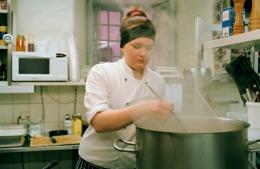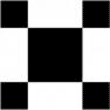LIINA SIIB "A Woman Takes Little Space"
 Palazzo Malipiero, S. Marco 3079, Venezia
Palazzo Malipiero, S. Marco 3079, Venezia
From June 4 to November 27, 2011
LIINA SIIB’s project A Woman Takes Little Space will represent Estonia at the 54th International Art Exhibition, La Biennale di Venezia.
The exhibition at the Estonian Pavilion is commissioned by the Center for Contemporary Arts, Estonia. The exhibition A Woman Takes Little Space consists of six conceptually connected room installations in an apartment-like, (un)homely environment. In her photo, video and site-specific room installations, the artist explores various topics, ranging from femininity and social space to different representations of women in contemporary society, as well as ‘feminine’ jobs and prostitution.
The title work of the exhibition, the photography series A Woman Takes Little Space (2007–2011), captures women of different ages and social status at their places of work. The title’s slightly awkward humour and reverse accusation highlights the exhibition’s most obvious level, one that arises from the politics of contemporary life. The series is inspired by a claim made in an opinion column on gender equality that appeared in the Estonian media a few years ago stating that women need less space for their everyday work (and less pay) than men. One of the questions that runs through the exhibition touches on the mechanisms that allow such ideas (though in the interests of political correctness they are quashed in public debate) to continue relatively unhindered as a result of an unsaid agreement between all parties. This problem of social inequality is of course not an independent issue, but grows out of many far deeper and more complex patterns of thinking and behaviour about the ‘essence’ of woman and gender roles that are interwoven and often go unnoticed.
While A Woman Takes Little Space addresses fairly obviously the surface issue (though the photographs not only encode but in part also decode one another, making the images many layered), the other works seem to attempt to take a step back and investigate at what levels and in what relationships these ‘naturally’ perceived role models emerge and how their actual conflict makes itself apparent in a variety of ways. In the installation A Room of One’s Own (2011) a video presents the housework and home life of housewives living in a new suburb close to Tallinn. These images are shown alongside Russian women dancing among themselves at an open-air concert in a wintery landscape. In the work Apartness (2008) there are photographs of middle-aged women who, having dressed themselves according to their idea of what men fantasize about, create a certain heightened trophy image of women. The video installation Averse Body (2007), filmed through a car window against views of Tallinn at night, involves interviews with prostitutes, in which the artist asks what they think of their bodes, what their clients think, what they would like to change about themselves, how much time they spend on their appearance and so forth.
Along with work that focuses on the private sphere and the body, there is also the video Unsocial Hours (2011), which explores the model of the cycle of women’s work and social life through food; to be more specific, cheap pastries produced in a bakery that works through the night and which are sold in the kiosks at Tallinn Railway Station, and eaten in cafes in Lasnamäe or during breaks by doctors and nurses working at Pelgulinn Hospital. Along with a focus on space, there is also a strong emphasis on time – the circling of time, and a certain element of ritual repetition and ‘not getting anywhere’. This kind of circling is not only typical of ‘women’s work’ or ‘women’s lives’, but at least in the context of this exhibition, the two main ways of perceiving and understanding this seem to be relatively equal to one another – repetition, on the one hand, is oppressive and mechanical (a ‘dead-end’ cycle), while on the other hand, in a more positive light, it is reproductive and stabilising (the cycle of ‘life’) – this not only speaks of the failure to ‘get ahead’, but possibly also of how unnecessary this is.
Men are only seen briefly in this exhibition, but their voice also has a place – as singing, or rather sounds, coming from the bathroom (His Song, 2011), as the announcer in the video Unsocial Hours, and in a slightly removed way in the work Averse Body, which is based on Jerzy Grotowski’s claim that prostitutes have a particular loathing for and lack of trust in their bodies. The answers given by the interviewees to the artist’s questions could be those given by any woman, sometimes they are more confident, other times doubtful, but in any case they seem to refute the idea of an aversion to their profession.
Press release compiled by Anu Allas
Liina Siib was born in 1963 in Tallinn, Estonia, where she currently lives and works. She studied graphic art and photography at the Estonian Academy of Arts, where she also earned an MA in photography. Her recent works examine different aspects of femininity, dealing with social space and subjectivity. She has had thirty solo exhibitions in Estonia, Germany, Belgium, France, Finland and Latvia. Her works have been presented at a number of exhibitions in Estonia, Europe, Asia and the USA. Her works are in the collections of the Art Museum of Estonia, the Tartu Art Museum, the Moderna Museet in Stockholm, the Neues Museum für Kunst und Design in Nuernberg etc.
The competition for the 2011 Estonian exhibit attracted 15 entries and the jury came to a final decision after two rounds of meetings. The winner was chosen by a seven-member panel of artists and representatives from various institutions. The panel members were Sirje Helme (Kumu Art Museum), Andres Kurg (Estonian Academy of Arts), Peeter Laurits (artist), Piret Lindpere (Estonian Ministry of Culture), Reet Mark (Tartu Art Museum), Johannes Saar (Center for Contemporary Arts, Estonia) and Ene-Liis Semper (artist).
The Center for Contemporary Arts, Estonia is the official representative of the Estonian exposition at the Venice Biennale. The venue for the Estonian exhibit in Venice in 2011 is the Palazzo Malipiero (1st floor), San Marco 3079, which is the same venue the Estonian exposition was shown at in 2003, 2005, 2007 and 2009.
Estonia’s participation at the 54th International Art Exhibition in Venice is commissioned by the Estonian Ministry of Culture, the Cultural Endowment of Estonia and organized by the Center for Contemporary Arts, Estonia and the Estonian Embassy in Rome.
Center for Contemporary Arts, Estonia (www.cca.ee)
Vabaduse väljak 6, 10146 Tallinn, Estonia
e-mail: post[at]cca dot ee
Johannes Saar johannes[at]cca dot ee (commissioner)
Elin Kard elin[at]cca dot ee (deputy commissioner)
____________________________
Image: from the series 'A Woman Takes Little Space', Liina Siib, 2007 - 2009
PRESS MATERIALS CAN BE FOUND HERE



 Palazzo Malipiero, S. Marco 3079, Venezia
Palazzo Malipiero, S. Marco 3079, Venezia